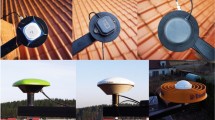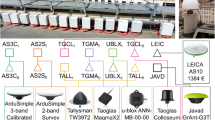Abstract
This paper is concerned with the maximum-likelihood (ML) calibration methods tailored to the antenna arrays whose spatial responses are perturbed by mutual coupling effects and unknown sensor gain/phase responses. Unlike the existing work, the proposed methods are capable of jointly exploiting the spatial-domain information and time-domain waveform information of the calibration sources. Two kinds of numerical optimization algorithm are devised dependent on different array geometries. One is suitable for arbitrary irregular array manifold, while the other applies to some particular uniform arrays. Additionally, based on the maximum a posteriori probability (MAP) criterion, we extend the two algorithms to the scenario where the true values of the calibration source azimuths deviate slightly from the nominal ones with a priori known Gaussian distribution. The Cramér–Rao bound (CRB) expressions for the unknowns are derived in the absence and presence of the azimuth deviations, respectively. Simulation results support that the performances of the proposed algorithms are preferable to the ones which merely employs the spatial-domain information of the calibration sources, and are able to attain the corresponding CRB.













Similar content being viewed by others
References
C.Y. Cheng, Y.H. Lv, Mutual coupling calibration algorithm of array antennas and its error estimation, in Proc. Int. Conf. on Signal Process, Beijing, China (2004), pp. 487–490
Q. Cheng, Y.B. Hua, P. Stoica, Asymptotic performance of optimal gain-and-phase estimators of sensor arrays. IEEE Trans. Signal Process. 48, 3587–3590 (2000)
A. Ferréol, P. Larzabal, M. Viberg, On the asymptotic performance analysis of subspace DOA estimation in the presence of modeling errors: case of MUSIC. IEEE Trans. Signal Process. 54, 907–920 (2006)
A. Ferréol, P. Larzabal, M. Viberg, On the resolution probability of MUSIC in presence of modeling errors. IEEE Trans. Signal Process. 56, 1945–1953 (2008)
A. Ferréol, P. Larzabal, M. Viberg, Performance prediction of maximum-likelihood direction-of-arrival estimation in the presence of modeling errors. IEEE Trans. Signal Process. 56, 4785–4793 (2008)
A. Ferréol, P. Larzabal, M. Viberg, Statistical analysis of the MUSIC algorithm in the presence of modeling errors: taking into account the resolution probability. IEEE Trans. Signal Process. 58, 4156–4166 (2010)
B. Friedlander, A.J. Weiss, Direction finding in the presence of mutual coupling. IEEE Trans. Antennas Propag. 39, 273–284 (1991)
H.T. Guo, X. Zheng, Y.X. Li, Estimation of mutual coupling coefficient of the array by simulated annealing algorithm. Wuhan Univ. J. Nat. Sci. 10, 1000–1004 (2005)
X.Q. Hu, H. Chen, Y.L. Wang, J.W. Chen, A self-calibration algorithm for cross array in the presence of mutual coupling. Sci. China Ser. F: Inf. Sci. 54, 836–848 (2011)
A.G. Jaffer, Constrained mutual coupling estimation for array calibration, in Proc. IEEE Int. Conf. on Signal, Syst and Computers, Pacific Grove, CA (2001), pp. 1273–1277
Y.K. Jia, Z. Bao, H. Wu, A new calibration technique with signal sources for position, gain and phase uncertainty of sensor array. Acta Electron. Sin. 24, 47–52 (1996)
J.L. Liang, X.J. Zeng, W.Y. Wang, H.Y. Chen, L-shaped array-based elevation and azimuth direction finding in the presence of mutual coupling. Signal Process. 91, 1319–1328 (2011)
M. Lin, Z.Q. Gong, Subspace-based calibration approach for mutual coupling among sensors. Acta Electron. Sin. 29, 1176–1178 (2001)
C. Liu, Z.F. Ye, Y.F. Zhang, Autocalibration algorithm for mutual coupling of planar array. Signal Process. 90, 784–794 (2010)
A.F. Liu, G.S. Liao, C. Zeng, Z.W. Yang, Q. Xu, An eigenstructure method for estimating DOA and sensor gain-phase errors. IEEE Trans. Signal Process. 59, 5944–5956 (2011)
B.C. Ng, A. Nehorai, Active array sensor localization. Signal Process. 44, 309–327 (1995)
B.C. Ng, C.M.S. See, Sensor array calibration using a maximum-likelihood approach. IEEE Trans. Antennas Propag. 44, 827–835 (1996)
H.Y. Park, C.Y. Lee, H.G. Kang, D.H. Youn, Generalization of subspace-based array shape estimations. IEEE J. Ocean. Eng. 29, 847–856 (2004)
M. Pesavento, A.B. Gershman, K.M. Wong, Direction finding in partly calibrated sensor arrays composed of multiple subarrays. IEEE Trans. Signal Process. 50, 2103–2115 (2002)
C. Qi, Y. Wang, Y. Zhang, H. Chen, DOA estimation and self-calibration algorithm for uniform circular array. Electron. Lett. 41, 1092–1094 (2005)
C.M.S. See, Sensor array calibration in the presence of mutual coupling and unknown sensor gains and phases. Electron. Lett. 30, 373–374 (1994)
C.M.S. See, Method for array calibration in high-resolution sensor array processing. IEE Proc. Radar Sonar Navig. 142, 90–96 (1995)
C.M.S. See, B.K. Poth, Parametric sensor array calibration using measured steering vectors of uncertain locations. IEEE Trans. Signal Process. 47, 1133–1137 (1999)
F. Sellone, A. Serra, A novel mutual coupling compensation algorithm for uniform and linear arrays. IEEE Trans. Signal Process. 55, 560–573 (2007)
V.C. Soon, L. Tong, Y.F. Huang, R. Liu, A subspace method for estimating sensor gains and phases. IEEE Trans. Signal Process. 42, 973–976 (1994)
P. Stoica, E.G. Larsson, Comments on “Linearization method for finding Cramér-Rao bounds in signal processing”. IEEE Trans. Signal Process. 49, 3168–3169 (2001)
M. Viberg, A.L. Swindlehurst, A Bayesian approach to auto-calibration for parametric array signal processing. IEEE Trans. Signal Process. 42, 3495–3507 (1994)
D. Wang, Y. Wu, Array errors active calibration algorithm and its improvement. Sci. China Ser. F: Inf. Sci. 53, 1016–1033 (2010)
A.J. Weiss, B. Friedlander, Eigenstructure methods for direction finding with sensor gain and phase uncertainties. Circuits Syst. Signal Process. 9, 272–300 (1990)
S.J. Wijnholds, A. van der Veen, Multisource self-calibration for sensor arrays. IEEE Trans. Signal Process. 57, 3512–3522 (2009)
Z.F. Ye, C. Liu, 2-D DOA estimation in the presence of mutual coupling. IEEE Trans. Antennas Propag. 56, 3150–3158 (2008)
Acknowledgements
The author would like to thank the Associate Editor and all the anonymous reviewers for their valuable comments and suggestions which vastly improved the content and presentation of this paper. The author also acknowledges support from National Science Foundation of China under Grants 61201381 and the Future Development Foundation of Zhengzhou Information Science and Technology College under Grants YP12JJ202057.
Author information
Authors and Affiliations
Corresponding author
Appendices
Appendix A: Proof of (22)–(24)
In light of the first-order derivation operator of the orthogonal projection matrix, it follows that

The substitution of (86) into (20) yields

which implies that

Similarly, it follows that
On the other hand, after some algebraic manipulations we can approximately obtain

which results in

Through similar derivation, it can also be concluded that
Based on the above analysis, (22)–(24) hold true.
Appendix B: Proof of (33)–(37)
Following the same procedure as in Appendix A leads to

which implies that

On the other hand, making some algebraic effort we can approximately obtain

which yields

Based on the above analysis, equalities (33)–(37) are proved.
Appendix C: Proof of (40)–(43)
Follow along the line of the derivation in Appendix B results in

which implies that

On the other hand, after some algebraic manipulations we can approximately obtain

which yields

Rights and permissions
About this article
Cite this article
Wang, D. Sensor Array Calibration in Presence of Mutual Coupling and Gain/Phase Errors by Combining the Spatial-Domain and Time-Domain Waveform Information of the Calibration Sources. Circuits Syst Signal Process 32, 1257–1292 (2013). https://doi.org/10.1007/s00034-012-9499-6
Received:
Revised:
Published:
Issue Date:
DOI: https://doi.org/10.1007/s00034-012-9499-6




